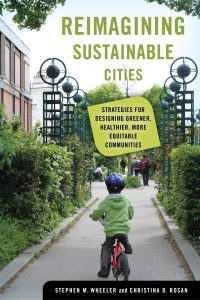In Reimagining Sustainable Cities: Strategies for Designing Greener, Healthier, More Equitable Communities, Stephen M. Wheeler and Christina D. Rosan explore ways to make urban places more sustainable, drawing on examples from across the world. This book presents a rich and useful starting point for reimagining and reinvigorating cities today, writes Helen Traill.
Reimagining Sustainable Cities: Strategies for Designing Greener, Healthier, More Equitable Communities. Stephen M. Wheeler and Christina D. Rosan. University of California Press. 2021.
Find this book (affiliate link):![]()
 Reimagining Sustainable Cities is a wide-ranging book, drawing together examples from across the world (but with a stronger focus on the US and Europe) to explore ways to transform urban places towards sustainability. The scope of the book is broad, combining research on the economy, energy, inequality, transport, green space, democracy and the power of changes that people can make in their everyday lives.
Reimagining Sustainable Cities is a wide-ranging book, drawing together examples from across the world (but with a stronger focus on the US and Europe) to explore ways to transform urban places towards sustainability. The scope of the book is broad, combining research on the economy, energy, inequality, transport, green space, democracy and the power of changes that people can make in their everyday lives.
As an introduction and guide to possible urban futures, Reimagining Sustainable Cities chimes with the recent Intergovernmental Panel on Climate Change report that suggested that we already have everything we need to get to net zero carbon. Yet, much like Karl Marx’s refusal to write recipes for the cookshops of the future, authors Stephen M. Wheeler and Christina D. Rosan are not prescriptive about what the pathway to a more sustainable future must look like. Instead, they introduce the reader to the myriad practices and possibilities that exist as experiments, ideas or already implemented policies. In this sense, they succeed in laying out the shape of the broad and multifaceted urban sustainability question. The book’s plurality recalls the experimental and piecemeal fashion through which cities across the world are attempting to piece together a climate-adapted future (see particularly Harriet Bulkeley and Vanesa Castán Broto, 2021; and Bulkeley et al, 2018).

Photo by Vuitton Lim on Unsplash
The book is structured around a series of questions that move across different scales and foci, such as ‘How Do We Get to Climate Neutrality?’ and ‘How Can Cities Better Support Human Development?’ Each chapter explains the problem and a series of solutions, helpfully set out in a table and with additional useful tables to quickly illustrate the suggested pathways. The conclusions to each chapter also act as summaries of what a sustainable future might look like, often written in the future tense, which is somewhat unusual for a text authored by academics.
The structure works well for producing digestible chapters and should enable the reader to dip back into and find ideas easily, though it can be slightly repetitive for those who start at the beginning and read to the end. That said, the explicit aim of the book is to reach a wide audience and present the material accessibly. In this, it generally succeeds. The downside to this approach is that while the book collects a dazzlingly broad array of ideas and examples, it tends to lack a great deal of detail in the examples it offers, taking a path that demonstrates breadth rather than depth. To this end, it often signposts more than it fully explains, leading it to skim across lots of different spaces and ideas.
The core aim of the book is to address the need for ‘dramatic change’ (2) towards sustainable futures, not only as a technical problem of emissions but as an opportunity to pursue broad social change and urban justice. Sustainability is treated as ‘a process of continually and actively moving in directions that promote ecological health, social equity, quality of life, cooperation, and compassion’ (4). This sense of plural and broad sustainability guides the book, emerging throughout in bold statements about the need for ‘Personal values [that] emphasize giving back to the world, not profiting from it’ (192). Not everyone will agree with some of the ideas around wide-ranging taxation, rent control, economic redistribution and the necessity of centring ‘care and community and healing’ (192). Nonetheless, there is a strong radical imagination within the book that enables it to cover a range of terrains from the technical details of planning systems through to strategies for reinvigorating democracy.
The book’s tone is unusual for an academic text, in part because it aims to be accessible and in part because of its focus on solutions. The insistence that sustainability is an opportunity reflects the self-stated goal ‘to be constructive and empowering rather than depressing and paralyzing’ (2). At times this feels like a slightly off-putting insistence on positivity, with an appropriately utopian way of approaching planning to ‘promote happiness, quality of life, and fulfilment of human potential’ (205). This all becomes much clearer as an approach when it is explored in greater depth in Chapter Twelve on ‘How Can Each of Us Help Lead the Move toward Sustainable Communities?’ When the reader reaches this point, it becomes evident how strategic the tone and direction of the book actually are, though its insistently sunny presentation of solutions does at times grate. Starting here may allow the reader to more easily read with this book if they are approaching it as an academic who is perhaps more used to critique as both tone and approach.
Nevertheless, while there might be small details to quibble – such as the claim that many urban sustainability and greenhouse gas reduction plans ignore consumption and lifestyle questions – the book is generally a helpful guide to the range of potential sustainable city action. Wheeler and Rosan present a rich and useful starting point for reimagining and reinvigorating cities with a deliberately kaleidoscopic and relatively non-prescriptive approach. In this, I suspect the reader of Reimagining Sustainable Cities will find many ideas to take further.
Note: This review gives the views of the author, and not the position of the LSE Review of Books blog, or of the London School of Economics and Political Science. The LSE RB blog may receive a small commission if you choose to make a purchase through the above Amazon affiliate link. This is entirely independent of the coverage of the book on LSE Review of Books.
Banner image credit: Photo by Victor on Unsplash







